Truly Super Superbells®
With the right sun, water, fertilizer and a bit of care you can grow truly super Superbells®.
Superbells® Calibrachoa are excellent summer performing annuals, as long as their needs are met. They are heat tolerant, will tolerate dry conditions and bloom prolifically all summer without deadheading. As with most plants, the critical elements for success are sun, fertilizer, soil and water. Having great looking Superbells® all summer takes providing for these needs. Fortunately, getting them what they need is relatively simple. I'll start from the top.
Sun
Superbells® are considered full sun plants. This means they will do best with a minimum of 6 hours of direct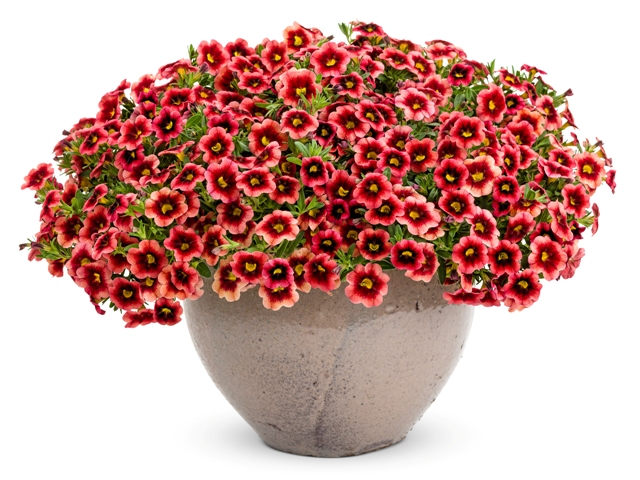 sun a day. They will do OK in a part sun location, 4-6 hours of direct sun a day, but flower number will decrease and the plants will stretch and look more open. If your plants aren't getting enough sun, the foliage turns light green, they stretch and the bloom number will decrease or blooming may stop all together. Move your plants to a location where they get at least 6 hours of direct sun a day and give the plants a trim, taking off 1 to 4 inches. The trim will neaten the appearance of the plants and encourage additional branching. You will end up with fuller plants and more flowers as the plants recover from receiving too little sun.
sun a day. They will do OK in a part sun location, 4-6 hours of direct sun a day, but flower number will decrease and the plants will stretch and look more open. If your plants aren't getting enough sun, the foliage turns light green, they stretch and the bloom number will decrease or blooming may stop all together. Move your plants to a location where they get at least 6 hours of direct sun a day and give the plants a trim, taking off 1 to 4 inches. The trim will neaten the appearance of the plants and encourage additional branching. You will end up with fuller plants and more flowers as the plants recover from receiving too little sun.
Fertilizer
Fertilizer is key for flowering in all Superbells® Calibrachoa and Supertunia® Petunias. Since they put out constant flowers all summer, they need to keep their strength up. Symptoms of not enough fertilizer are almost the exactly the same as when they don't get enough sun, so fertilizing every other week with a liquid fertilizer (or once a month if you are also using a slow release fertilizer) is a great way to make sure your Superbells® are in top shape. I usually provide a slow or controlled release fertilizer when I am planting them. This fertilizer will normally last about two months, although specific fertilizers will differ. Consult the package directions for your fertilizer for the length of time it will be effective and dosage instructions.
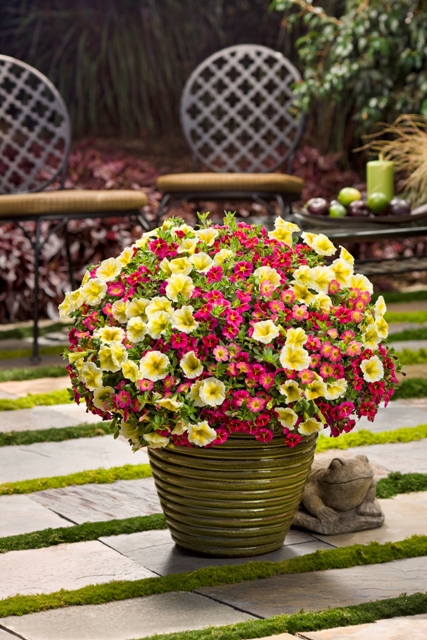 After 6 weeks to two months, as the summer heats up and the original dose of fertilizer starts to run out, I will begin to use a water soluble fertilizer. Most water soluble fertilizers are used every 10 days to two weeks. Again, it is always best to follow the directions on your fertilizer package.
After 6 weeks to two months, as the summer heats up and the original dose of fertilizer starts to run out, I will begin to use a water soluble fertilizer. Most water soluble fertilizers are used every 10 days to two weeks. Again, it is always best to follow the directions on your fertilizer package.
We suggest buying a well-balanced fertilizer that has an N-P-K ratio around 2:1:2 or 2:1:1.5. Common formulations include 20-10-20 and 20-10-15. A fertilizer with this ratio will provide the necessary nitrogen (N), phosphorous (P) and potassium (K) for the plants to thrive.
There are many "bloom booster" fertilizers on the market. These are very tempting fertilizers. Who wouldn't want to boost blooms? Bloom booster fertilizers usually feature a high P (middle number) ratio. However, plants can only use a certain amount of phosphorous at once. Adding more doesn't mean the plant uses more. The fertilizer ratio we suggest provides all of the phosphorous a plant needs and adding more won't impact your plant. We firmly believe that if your plant is happy, then blooms will follow. A well-balanced fertilizer will keep your plant happy and the flowers will burst out all over.
If you've grown Calibrachoa, it is likely that at some point the foliage started to get light green or yellowish. If this happens, the first thing to ask yourself is "Have I been fertilizing?" If your answer is, no I haven't been fertilizing, then the yellow foliage is because the plants are starving. Start fertilizing. To help your plants recover quickly, use a water soluble fertilizer. After they green back up, you can add a slow or controlled release fertilizer instead or keep using the water soluble.
If the answer to "Have I been fertilizing?" is yes, I used a slow or controlled release fertilizer when I planted and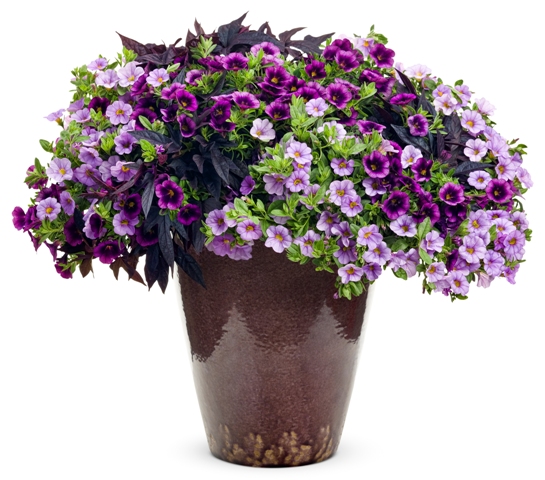 if it has been 6 weeks or longer since you fertilized, then your controlled or slow release fertilizer probably is no longer available in the quantities necessary to keep the plant happy. Begin fertilizing with a water soluble fertilizer. After the plants are green and happy again, you can add a new dose of controlled release fertilizer or continue using the water soluble fertilizer. As always, follow the package directions.
if it has been 6 weeks or longer since you fertilized, then your controlled or slow release fertilizer probably is no longer available in the quantities necessary to keep the plant happy. Begin fertilizing with a water soluble fertilizer. After the plants are green and happy again, you can add a new dose of controlled release fertilizer or continue using the water soluble fertilizer. As always, follow the package directions.
If the answer to "Have I been fertilizing?" is yes, I've been fertilizing plenty, but my plants are still getting light green (and they are getting 6+ hours of sun a day), then your plant isn't getting enough iron. Bear with me, this explanation is going to take a bit. Calibrachoa, as a class of plants, tend to be more sensitive than many plants to changes in pH. The pH of your soil is impacted most by your water. Some water will keep the pH just where it needs to be. Some will cause the pH to become high, in other cases the pH will become too low. If the pH of your soil gets too high or too low, Calibrachoa are unable to take up enough iron to keep the foliage healthy and the plants happy.
Iron is included in all commercial fertilizers. However, the usual form of iron that is included in fertilizers is only available to plants at a relatively narrow pH range. Calibrachoa need more iron than many plants to remain at their best and will look sick when other plants look fine. Our Proven Winners® plant foods use a form of iron that is available at a wider range of pH and are wonderful fertilizers to use with Calibrachoa. You should also be able to buy supplemental iron from your local garden center. There are even forms that can be sprayed on the foliage that will almost instantly help your plants get their green mojo back. Your local garden center can help you select the right product for your needs.
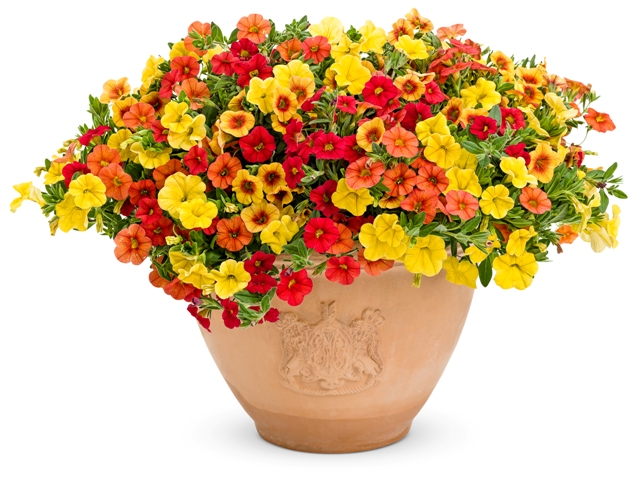
Feed Me, Seymour has more in-depth information on fertilizing plants.
Soil
Calibrachoa prefer very well-drained soils. Most of us don't have excellent drainage in our gardens, so we suggest that Superbells® be grown in containers. If you do have excellent drainage in your garden, then Superbells® will be a wonderful garden plant for you. Excellent drainage comes with sandy or loam soils and raised beds. I do think that most of us will have the best success when growing Calibrachoa in containers. I use them exclusively in containers because my clay soil doesn't provide good drainage. They do perform well in my containers.
It is also important to use a good quality potting soil in your containers. Roots are the foundation of any plant and good potting soil is necessary for plants to develop a good root system. The Dirt on Dirt - Potting Soil gives guidelines for selecting a good, well draining, potting soil.
Water
Soil and watering go hand-in-hand in keeping your Superbells® happy. The root system of Calibrachoa tends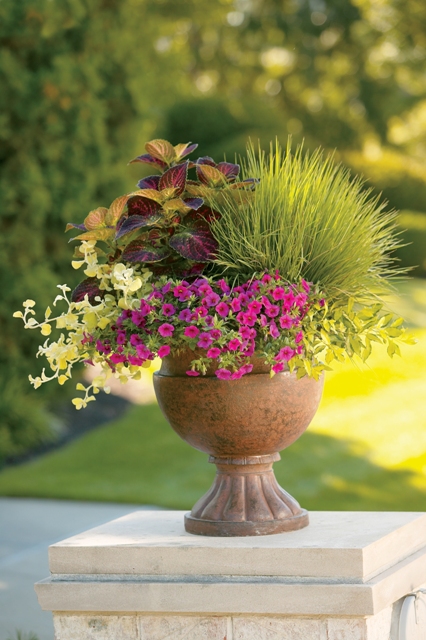 to be sensitive to "wet feet." This simply means they don't like sitting in wet soils and they need to be planted where they will get excellent drainage, which we discussed above. Keeping soil from over-saturation is key to keeping your plants happy. Be sure that the containers you choose have drainage holes. We select our Superbells® to have better tolerance than other Calibrachoa to wet soil, however, they still prefer a well-drained soil and proper watering.
to be sensitive to "wet feet." This simply means they don't like sitting in wet soils and they need to be planted where they will get excellent drainage, which we discussed above. Keeping soil from over-saturation is key to keeping your plants happy. Be sure that the containers you choose have drainage holes. We select our Superbells® to have better tolerance than other Calibrachoa to wet soil, however, they still prefer a well-drained soil and proper watering.
The best way to water for almost all container plants is water when the top of the soil is dry to the touch and then water enough that some liquid drains from the container. You want to saturate the whole container. As long as you don't water too often and use a good potting soil, the soil will not stay too wet. It is important to saturate all of the soil because this will encourage the roots to grow all the way to the bottom of the container. More roots, in general, will mean happier plants. Water Your Way to Happy Plants has more in-depth information on watering container plants. If you are going to try to grow Superbells® in the ground, Should I Water or Is It Going to Rain? has more information on watering landscapes.
Every year we will get quite a few questions on our website that ask something along the lines of "Why is my plant wilting even though the soil is wet?" If a plant is wilting even though the soil is wet there are two likely reasons. First, the soil was dry, the plant wilted, you watered, but the plant hasn't had enough time to take up enough water to recover. Getting enough water to make the foliage turgid again takes a while. Give your plant time to recover.
However, almost always when this question is posed, the answer is that the soil was kept too wet for a period of time which 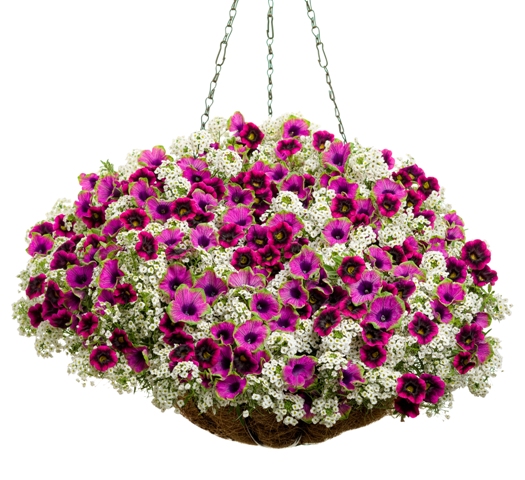 caused your plant to develop a root rot problem. A wilted plant with wet soil is an excellent indicator that a plant was kept too wet and has root rot. Wait, That Plant is Drowning! details how to determine if your plant has root rot and how to help it recover.
caused your plant to develop a root rot problem. A wilted plant with wet soil is an excellent indicator that a plant was kept too wet and has root rot. Wait, That Plant is Drowning! details how to determine if your plant has root rot and how to help it recover.
Other Things to Consider
Other than the root rot issues we touched on in the water section, Superbells® don't really have other common pest or disease problems. If your plant has stopped flowering, check to make sure that you've provided the conditions detailed above. If you have, then it is time to investigate if a pest or disease might be causing you issues. These are difficult to diagnose via email. Fortunately, in the US Cooperative Extension provides local help for gardeners. Cooperative Extension agents are often more adept at identifying issues because they know what pest and disease problems exist locally. This website will help you locate contact information for your local agent. We are always available to help too.
Flowers, What Flowers? may also be helpful in diagnosing issues that cause plants to stop flowering and can help get those plants flowering again.
Please don't get the idea that Calibrachoa, Superbells® in particular, are difficult plants. They will do great if provided a sunny location, well-drained soil, adequate fertilizer to keep them flowering and proper watering. Almost all sun plants will do well if provided these conditions.




